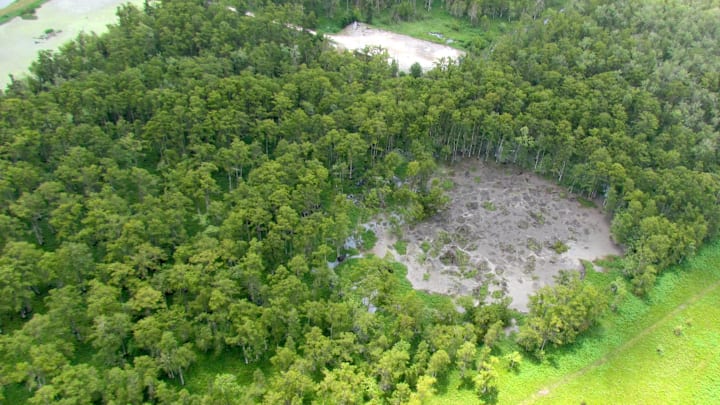In Louisiana’s bayou country, the buzz of the cicadas used to be the loudest thing you’d hear. Spanish moss draped the trees and the thick humidity hung in the air, creating a serene backdrop for residents who spent their time watching the lazy waters flow past them. Little seemed to change until 2012, when the earth convulsed and a sinkhole opened in Bayou Corne, swallowing acres of swampland and upending the community.
First, residents had noticed bubbling at the surface of the slow-moving stream. They assumed it was a gas pipeline leaking—the whole parish is criss-crossed by pipelines carrying natural gas and chemicals—but the events of the coming months would tell a different story. On the morning of August 3, the ground opened and created a water-filled chasm 325 feet wide and hundreds of feet deep. It took everything in its path, engulfing 100-foot-tall trees and draining water from nearby swamps. Methane wafted into the air.
All 350 residents of the tiny community were forced to leave under a mandatory evacuation order issued just hours after the sinkhole was discovered. Only a handful chose to return to the area when the order was lifted.
And the sinkhole is still growing.
The Price of Salt
The state of Louisiana sits on an ancient seabed of the Gulf of Mexico. The regular influx of seawater over land created salt fields that were eventually covered by rocks.
In at least 127 places in the state, massive underground salt domes—subterranean formations that occur when salt pushes upwards into the overlying rocks—have grown over centuries, sometimes thousands of feet high. The Napoleonville salt dome found beneath Bayou Corne stretches three miles long and one mile wide, reaching depths of at least 30,000 feet.
These domes can create natural traps for oil and gas and are valuable sources of salt and sulfur. It’s also possible to hollow them out with water, allowing them to serve as open caverns for natural gas storage. This storage method is often more economical than sequestering gas in existing oil fields or aquifers—making the salt domes an attractive solution for energy companies. The Napoleonville dome isn’t entirely hollow, but it does have over 50 caverns created by the process of mining and extracting salt, and multiple companies have used it over the years to store gases and create saltwater for chemical factories.
Texas Brine Co., a Houston-based mining company, began excavating a cavern in the Napoleonville dome’s edge in 1982, digging it to 300 feet wide and almost half a mile deep. It was used to extract saltwater for Occidental Chemical Corp., the company that owned the cavern, until 2011.
But the following year, the dome collapsed. That underground vacuum spawned the sinkhole that devoured Bayou Corne.
A flurry of lawsuits followed. Texas Brine took most of the heat for the sinkhole, as experts initially faulted the company for excessive drilling into the dome’s supporting wall, causing the collapse. However, in 2015, Texas Brine strategically shifted blame onto Occidental Chemical Corp., seeking $100 million in damages and asserting that Occidental had mismanaged a previous oil well, weakening the salt dome’s structure and causing the disaster.
In 2018, Texas Brine was found to be only 35 percent legally responsible for the sinkhole, with Occidental Chemical Corp. shouldering half the blame and Vulcan Materials, a previous owner of the dome, bearing 15 percent.
In addition, as a result of a class-action lawsuit, Texas Brine was ordered to purchase over 150 residences in the largely abandoned community [PDF]. The company has been required to pay out at least $48.1 million to residents in the form of home offers so far, although the recouped amounts remain part of ongoing legal processes.
“A Glimpse of Hell on Earth”
“We were living in what truly is a bayou paradise,” Dennis Landry, a retired teacher who moved to Bayou Corne in the early 1990s, told Newsweek. After the sinkhole erupted, Landry asked to be flown over the area to see the event that was threatening his property.
“When I passed over the sinkhole, I thought I caught a glimpse of hell on Earth,” he said.

After the majority of residents had to evacuate, nearby businesses were also forced to close. Although some tried to return to their homes when the evacuation order was lifted, many homeowners had to leave permanently due to property damage, pollution, and the decimated local economy. In 2012, about 350 people lived in the Bayou Corne community. In 2021, that number was down to 38 mainly senior citizens.
Immediately after the sinkhole appeared in 2012, chemicals that can harm human health were found in the area but at concentrations not high enough to cause immediate issues. The hole continues to emit polluting gases and trigger small earthquakes.
Uncertain Future
By 2018, the sinkhole had grown to 34 acres in area and 750 feet deep—and it’s still expanding. Of the residents who did try to make Bayou Corne home again, many ultimately had to move elsewhere. “We were forced out of our lives,” long-time resident Carla Alleman told Newsweek.

Candy Blanchard, another displaced resident, told the magazine, “We are not out of a house. We are out of a home.”
A few people who still live in the area are fighting for compensation from Texas Brine, since they’re unable to sell their homes in the blighted area.
Geologists believe that the sinkhole will naturally stop enlarging at some point, perhaps when it reaches about 50 acres in size, but they’re unsure how long that will take. For now, the giant hole in the quiet bayou will continue to grow, and displaced families will still look for justice.
